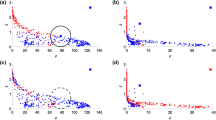Abstract
Fixed point clusters (FPCs) are based on the idea that local optima of redescending M-estimators can be used to locate clusters. FPCs satisfy a fixed point condition which means that they are data subsets that do not contain any outlier and with respect to that all other points in the data set are outliers. In this paper, outliers are defined in terms of the Mahalanobis distance. Crisp FPCs (where outlyingness is defined with a 0–1 weight function) are compared to fuzzy FPCs where outliers are smoothly downweighted. An algorithm to find substantial crisp and fuzzy FPCs is proposed, the results of a simulation study and a data example are discussed.
Access this chapter
Tax calculation will be finalised at checkout
Purchases are for personal use only
Preview
Unable to display preview. Download preview PDF.
Similar content being viewed by others
References
ANDREWS, D.F., BICKEL, P.J., HAMPEL, F.R., HUBER, P.J., ROGERS, W.H., and TUKEY, J.W. (1972): Robust Estimates of Location: Survey and Advances. Princeton University Press, Princeton NJ.
BAIER, D., GAUL, W., and SCHADER, M. (1997): Two-Mode Overlapping Clustering With Applications to Simultaneous Benefit Segmentation and Market Structuring. In: R. Klar and O. Opitz (Eds.): Classification and Knowledge Organization. Springer, Berlin, 557–566.
BECKER, C. and GATHER, U. (1999): The masking breakdown point of multivariate outlier identification rules. Journal of the American Statistical Association, 94, 947–955.
GAUL, W. and SCHADER, M. (1994): Pyramidal Classification Based on Incomplete Dissimilarity Data. Journal of Classification, 11, 171–193.
HAMPEL, F.R. (1975): Beyond location parameters: Robust concepts and methods. Bulletin of the International Statistical Institute 46-Proceedings of the 40th Session, 375–382.
HAMPEL, F.R. (2002): Some Thoughts about Classification. In: K. Jajuga, A. Sokolowski, and H.-H. Bock (Eds.): Classification, Clustering, and Data Analysis. Springer, Berlin, 5–26.
HAMPEL, F.R., RONCHETTI, E.M., ROUSSEEUW, P.J. and STAHEL, W.A. (1986): Robust Statistics. Wiley, New York.
HENNIG, C. (1997): Fixed Point Clusters and their Relation to Stochastic Models. In: R. Klar and O. Opitz (Eds.): Classification and Knowledge Organization, Springer, Berlin, 20–28.
HENNIG, C. (2002): Fixed point clusters for linear regression: computation and comparison. Journal of Classification, 19, 249–276.
HENNIG, C. (2003): Clusters, Outliers, and Regression: Fixed Point Clusters. Journal of Multivariate Analysis, 86, 183–212.
HENNIG, C. and CHRISTLIEB, N. (2002): Validating visual clusters in large datasets: fixed point clusters of spectral features. Computational Statistics and Data Analysis, 40, 723–739.
HUBER, P.J. (1981): Robust Statistics. Wiley, New York.
MÜLLER, C.H. and GARLIPP, T. (2005): Simple consistent cluster methods based on redescending M-estimators with an application to edge identification in images. Journal of Multivariate Analysis, 92, 359–385.
Author information
Authors and Affiliations
Editor information
Editors and Affiliations
Rights and permissions
Copyright information
© 2005 Springer-Verlag Berlin · Heidelberg
About this chapter
Cite this chapter
Hennig, C. (2005). Fuzzy and Crisp Mahalanobis Fixed Point Clusters. In: Baier, D., Decker, R., Schmidt-Thieme, L. (eds) Data Analysis and Decision Support. Studies in Classification, Data Analysis, and Knowledge Organization. Springer, Berlin, Heidelberg. https://doi.org/10.1007/3-540-28397-8_6
Download citation
DOI: https://doi.org/10.1007/3-540-28397-8_6
Publisher Name: Springer, Berlin, Heidelberg
Print ISBN: 978-3-540-26007-3
Online ISBN: 978-3-540-28397-3
eBook Packages: Mathematics and StatisticsMathematics and Statistics (R0)




